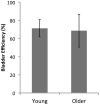Effect of filling rate on cystometric parameters in young and middle aged mice
- PMID: 28553656
- PMCID: PMC5443651
- DOI: 10.14440/bladder.2017.88
Effect of filling rate on cystometric parameters in young and middle aged mice
Abstract
Objectives: To investigate the effect of changing the bladder filling rate during cystometry in younger (2-3 months) and older (13-14 months) C57BL/6J male mice.
Methods: Cystometry was performed on mice under anesthesia. Voiding cycles were established in each mouse at a pump delivery rate of 17 μl/min. After 30 min, the rate was increased sequentially to 25, 33, 41 and 49 μl/min. Each rate was maintained for 30 min. The following cystometric parameters were quantified: peak pressure amplitude, intercontractile interval (ICI), compliance, micturition pressure threshold and voiding efficiency.
Results: Bladder weights were significantly greater in older mice (42 mg vs. 27 mg, P < 0.01), but functional capacities were not different. The pressure amplitudes did not change as filling rate increased, nor did they differ between the 4-month and 13-month-old males. ICIs were not significantly different between young and mature mice. However, both groups exhibited a non-linear reduction in ICI with increasing filling rate, best described by a power curve (R2 > 0.93). Compliance was higher in the older mice at low filling rates (17 and 25 μl/min) but this difference diminished at higher rates. Compliance decreased with increasing flow rate in a non-linear manner, again with greater effects at low filling rates. Micturition pressure thresholds increased with increasing flow rate in a linear manner and older mice began voiding at higher pressures than younger. Both young and old mice exhibited voiding efficiencies of ~70%.
Conclusions: The rate of volume delivery has complex effects on the timing of voiding and compliance. These findings argue for greater standardization of cystometry protocols and further investigation into afferent signaling to higher centers at different filling rates.
Keywords: compliance; cystometrogram; filling rate; mouse; urodynamics; volume delivery.
Conflict of interest statement
Competing interests: The authors have declared that no competing interests exist.
Figures




Similar articles
-
Evidence of central modulation of bladder compliance during filling phase.Neurourol Urodyn. 2012 Jan;31(1):30-5. doi: 10.1002/nau.21223. Epub 2011 Oct 28. Neurourol Urodyn. 2012. PMID: 22038779 Free PMC article.
-
Phasic changes in bladder compliance during filling cystometry of the neurogenic bladder.Ann Rehabil Med. 2014 Jun;38(3):342-6. doi: 10.5535/arm.2014.38.3.342. Epub 2014 Jun 26. Ann Rehabil Med. 2014. PMID: 25024957 Free PMC article.
-
[Recommendations for the urodynamic examination in the investigation of non-neurological female urinary incontinence].Prog Urol. 2007 Nov;17(6 Suppl 2):1264-84. Prog Urol. 2007. PMID: 18214138 Review. French.
-
Comparison of cystometric methods in female rats.Neurourol Urodyn. 2008;27(4):324-9. doi: 10.1002/nau.20512. Neurourol Urodyn. 2008. PMID: 17849479
-
Muro-Neuro-Urodynamics; a Review of the Functional Assessment of Mouse Lower Urinary Tract Function.Front Physiol. 2017 Feb 6;8:49. doi: 10.3389/fphys.2017.00049. eCollection 2017. Front Physiol. 2017. PMID: 28220079 Free PMC article. Review.
Cited by
-
Afferent nerve activity in a mouse model increases with faster bladder filling rates in vitro, but voiding behavior remains unaltered in vivo.Am J Physiol Regul Integr Comp Physiol. 2022 Nov 1;323(5):R682-R693. doi: 10.1152/ajpregu.00156.2022. Epub 2022 Sep 19. Am J Physiol Regul Integr Comp Physiol. 2022. PMID: 36121145 Free PMC article.
-
Non-invasive assessment of urinary bladder compliance using ultrasound: first validation study based on clinical urodynamic study.Ann Transl Med. 2021 Apr;9(7):547. doi: 10.21037/atm-20-6900. Ann Transl Med. 2021. PMID: 33987245 Free PMC article.
-
Urological complications of obesity and diabetes in males and females of three mouse models: temporal manifestations.Am J Physiol Renal Physiol. 2020 Jan 1;318(1):F160-F174. doi: 10.1152/ajprenal.00207.2019. Epub 2019 Nov 4. Am J Physiol Renal Physiol. 2020. PMID: 31682171 Free PMC article.
-
Reflex voiding in rat occurs at consistent bladder volume regardless of pressure or infusion rate.Neurourol Urodyn. 2023 Sep;42(7):1532-1546. doi: 10.1002/nau.25243. Epub 2023 Jul 9. Neurourol Urodyn. 2023. PMID: 37583249 Free PMC article.
-
Lack of expression of miR-29a/b1 impairs bladder function in male mice.Dis Model Mech. 2023 Jun 1;16(6):dmm050054. doi: 10.1242/dmm.050054. Epub 2023 Jun 7. Dis Model Mech. 2023. PMID: 37283037 Free PMC article.
References
Grants and funding
LinkOut - more resources
Full Text Sources
Other Literature Sources
